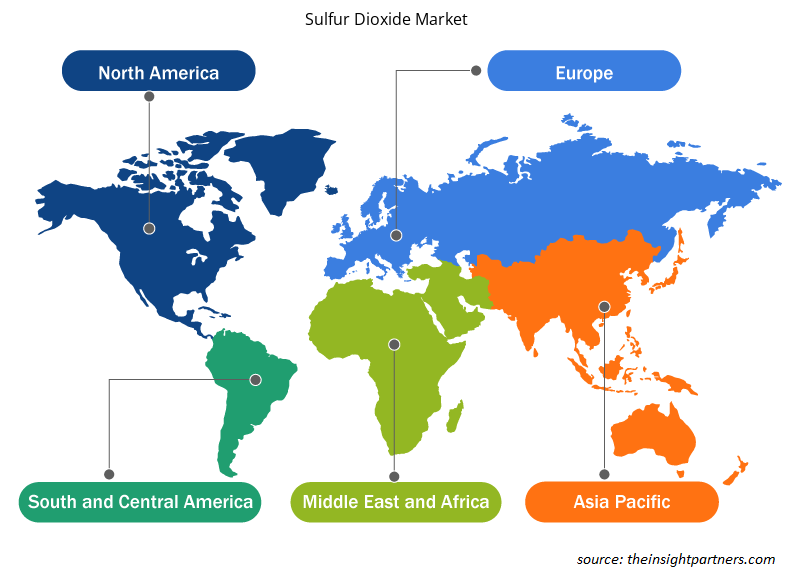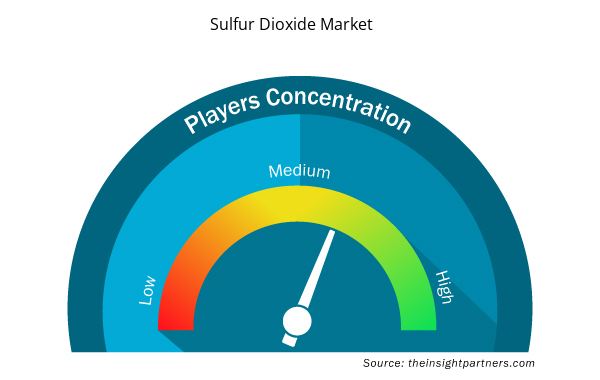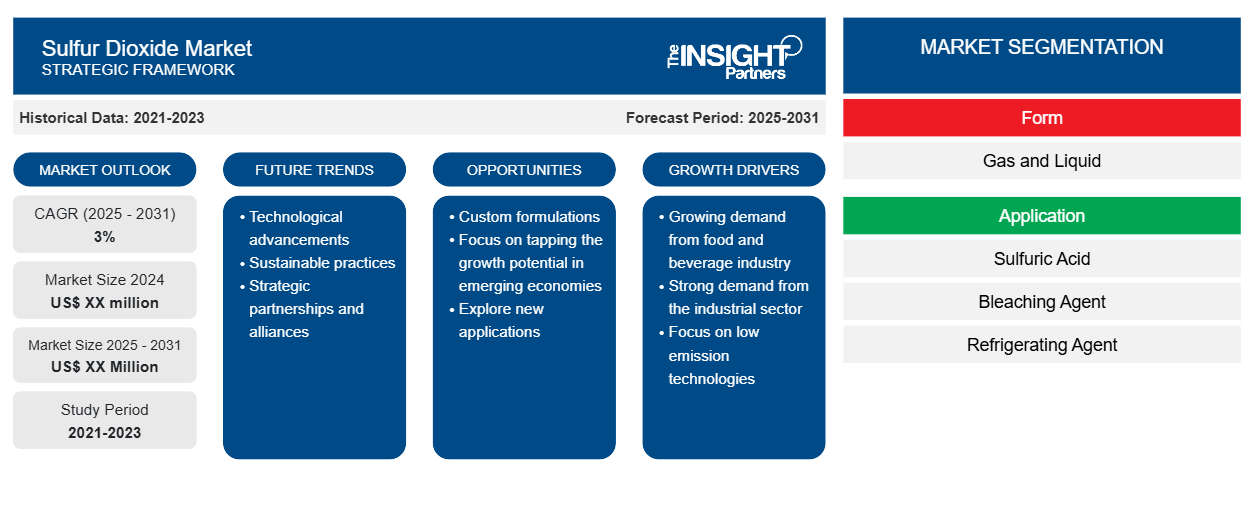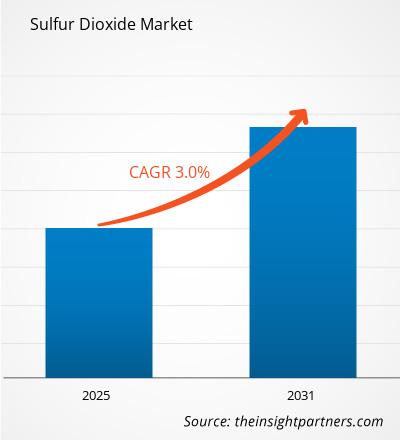The Sulfur Dioxide Market is expected to register a CAGR of 3% from 2023 to 2031, with a market size expanding from US$ XX Million in 2023 to US$ XX Million by 2031.
The report is segmented by form (gas and liquid), application (sulfuric acid, bleaching agent, refrigerating agent, food preservatives and others) and end use (chemicals, textiles, pulp and paper, food and beverages, water treatment and others). The global analysis is further broken-down at regional level and major countries. The market size and forecast at global, regional, and country levels for all the key market segments are covered under the scope. The report offers the value in USD for the above analysis and segments. The report provides key statistics on the market status of the key market players and offers market trends and opportunities.
Purpose of the Report
The report Sulfur Dioxide Market by The Insight Partners aims to describe the present landscape and future growth, top driving factors, challenges, and opportunities. This will provide insights to various business stakeholders, such as:
- Technology Providers/Manufacturers: To understand the evolving market dynamics and know the potential growth opportunities, enabling them to make informed strategic decisions.
- Investors: To conduct a comprehensive trend analysis regarding the market growth rate, market financial projections, and opportunities that exist across the value chain.
- Regulatory bodies: To regulate policies and police activities in the market with the aim of minimizing abuse, preserving investor trust and confidence, and upholding the integrity and stability of the market.
Sulfur Dioxide Market Segmentation
Form
- Gas and Liquid
Application
- Sulfuric Acid
- Bleaching Agent
- Refrigerating Agent
- Food Preservatives and Others
End Use
- Chemicals
- Textiles
- Pulp and Paper
- Food and Beverages
- Water Treatment and Others
Geography
- North America
- Europe
- Asia-Pacific
- South and Central America
- Middle East and Africa
Geography
- North America
- Europe
- Asia-Pacific
- South and Central America
- Middle East and Africa
Customize This Report To Suit Your Requirement
You will get customization on any report - free of charge - including parts of this report, or country-level analysis, Excel Data pack, as well as avail great offers and discounts for start-ups & universities
- Get Top Key Market Trends of this report.This FREE sample will include data analysis, ranging from market trends to estimates and forecasts.
Sulfur Dioxide Market Growth Drivers
- Growing demand from food and beverage industry: Sulfur dioxide is widely used as a preservative and antioxidant in the food and beverage sectors and is one of the primary driving forces of the sulfur dioxide market. SO2 is widely utilized in preventing spoilage and withstanding dry fruits, wines, and juices. As consumers begin favoring products that can last longer and the increasing demand for processed foods will escalate the requirements of effective preservatives like sulfur dioxide, this trend is particularly stronger in areas of expanding food processing industries.
- Strong demand from the industrial sector: Industrialization and urbanization in developing economies have played a vast role in expanding the sulfur dioxide market. Industries are being set up, and with this come various applications of sulfur dioxide, such as in chemical manufacturing and metal processing. Construction, automotive, electronics, and other sectors have generated demand for sulfur dioxide, especially in sulfuric acid production, which is a requisite in industrial processes.
- Focus on low emission technologies: Adjustment of emission controlling standards has affected sulfur dioxide markets. The new standards focus on emission control of SO2 from some sources; however, they open up opportunities for devising technologies that consume and capture sulfur dioxide. Industries are now considering emission control technology. This regulatory landscape encourages innovations and cleaner technology adoption, facilitating market growth.
Sulfur Dioxide Market Future Trends
- Technological advancements: Recent technological progress in the sulfur recovery process has kept up with production efficiency improvements with sulfur dioxide. Refinements to existing primary catalytic methods outside the Claus process are being made to augment sulfur recovery efficiencies from industrial emissions. This mitigates environmental degradation and ensures a more sustainable supply of sulfur dioxide for applications that drive the market.
- Sustainable practices: The trend is in a sustainable sulfur dioxide market where companies focus on limiting their footprints and achieving resource efficiency. The eco-friendly production options and principles of the circular economy. Manufacturers are currently exploring ways sulfur dioxide can be recycled and used in other processes in tandem with international sustainability.
- Strategic partnerships and alliances: The sulfur dioxide market is expected to witness increased strategic partnerships and collaborations between the key players in chemical manufacturing, technology provision, and research institutions. These alliances are intended to facilitate new product development, enhance distribution networks, and promote using sulfur dioxide for various applications. By sourcing knowledge from various sectors, companies would thus be able to speed up innovative government initiatives and increase their market potential.
Sulfur Dioxide Market Opportunities
- Custom formulations: The manufacturers develop their custom sulphur dioxide formulations, which can be used for various purposes. For instance, developing specific grades of sulphur dioxide to be used for individual application in the petroleum, food, or environmental processes would differentiate the companies in that dimension. Customized formulations for various industries, therefore, can totally form new revenue streams and build customer loyalty.
- Focus on tapping the growth potential in emerging economies: The sulfur dioxide market is rich with opportunities to expand its markets healthily into emerging countries, such as Asia-Pacific, Latin America, and Africa. It is these parts of the world where the rapid industrial development is going along with the rising investment in infrastructures, which would curtail the consumption of sulfur dioxide in various applications. Seizing this fantastic opportunity can mean establishing local production units and partnerships with regional distributors to access such markets easily.
- Explore new applications: The adaptability of sulfur dioxide has also given rise to curious applications within newer industries such as renewable energy and pharmaceuticals. For instance, sulfur dioxide could be used to manufacture solar cells or provide reagents in pharmaceutical synthesis. Thus, with further explorations into these usage areas, manufacturers could diversify their product range while tapping into growing markets with demand for high-performance chemicals.
Sulfur Dioxide Market Regional Insights
The regional trends and factors influencing the Sulfur Dioxide Market throughout the forecast period have been thoroughly explained by the analysts at Insight Partners. This section also discusses Sulfur Dioxide Market segments and geography across North America, Europe, Asia Pacific, Middle East and Africa, and South and Central America.

- Get the Regional Specific Data for Sulfur Dioxide Market
Sulfur Dioxide Market Report Scope
| Report Attribute | Details |
|---|---|
| Market size in 2023 | US$ XX million |
| Market Size by 2031 | US$ XX Million |
| Global CAGR (2023 - 2031) | 3% |
| Historical Data | 2021-2022 |
| Forecast period | 2024-2031 |
| Segments Covered | By Form
|
| Regions and Countries Covered | North America
|
| Market leaders and key company profiles |
|
Sulfur Dioxide Market Players Density: Understanding Its Impact on Business Dynamics
The Sulfur Dioxide Market market is growing rapidly, driven by increasing end-user demand due to factors such as evolving consumer preferences, technological advancements, and greater awareness of the product's benefits. As demand rises, businesses are expanding their offerings, innovating to meet consumer needs, and capitalizing on emerging trends, which further fuels market growth.
Market players density refers to the distribution of firms or companies operating within a particular market or industry. It indicates how many competitors (market players) are present in a given market space relative to its size or total market value.
Major Companies operating in the Sulfur Dioxide Market are:
- Boliden Group
- INEOS Group AG
- Praxair Technology, Inc.
- The Linde Group
- Kemira Oyj
Disclaimer: The companies listed above are not ranked in any particular order.

- Get the Sulfur Dioxide Market top key players overview
Key Selling Points
- Comprehensive Coverage: The report comprehensively covers the analysis of products, services, types, and end users of the Sulfur Dioxide Market, providing a holistic landscape.
- Expert Analysis: The report is compiled based on the in-depth understanding of industry experts and analysts.
- Up-to-date Information: The report assures business relevance due to its coverage of recent information and data trends.
- Customization Options: This report can be customized to cater to specific client requirements and suit the business strategies aptly.
The research report on the Sulfur Dioxide Market can, therefore, help spearhead the trail of decoding and understanding the industry scenario and growth prospects. Although there can be a few valid concerns, the overall benefits of this report tend to outweigh the disadvantages.
- Analyse historique (2 ans), année de base, prévision (7 ans) avec TCAC
- Analyse PEST et SWO
- Taille du marché Valeur / Volume - Mondial, Régional, Pays
- Industrie et paysage concurrentiel
- Ensemble de données Excel



Report Coverage
Revenue forecast, Company Analysis, Industry landscape, Growth factors, and Trends

Segment Covered
This text is related
to segments covered.

Regional Scope
North America, Europe, Asia Pacific, Middle East & Africa, South & Central America

Country Scope
This text is related
to country scope.
Questions fréquemment posées
Expansion in emerging markets is expected to be the key market trends
The report can be delivered in PDF/Word format, we can also share excel data sheet based on request.
On the basis of geography, the sulfur dioxide market is classified into North America, Europe, Asia Pacific, Middle East and Africa, and South and Central America
Boliden Group; INEOS; Tokyo Chemical Industry Co Ltd; SUMITOMO SEIKA CHEMICALS Co Ltd; ESSECO Srl are some of the key players operating in the sulfur dioxide market
The Sulfur Dioxide Market is estimated to witness a CAGR of 3% from 2023 to 2031
Growing demand in the food and beverage industry is driving the market growth
Trends and growth analysis reports related to Chemicals and Materials : READ MORE..
1. Boliden Group
2. INEOS Group AG
3. Praxair Technology, Inc.
4. The Linde Group
5. Kemira Oyj
6. Chemtrade Logistics Inc.
7. Calabrian Corporation
8. Grillo-Werke AG
9. PVS Chemicals Inc.
10. Esseco Group Srl
The Insight Partners performs research in 4 major stages: Data Collection & Secondary Research, Primary Research, Data Analysis and Data Triangulation & Final Review.
- Data Collection and Secondary Research:
As a market research and consulting firm operating from a decade, we have published and advised several client across the globe. First step for any study will start with an assessment of currently available data and insights from existing reports. Further, historical and current market information is collected from Investor Presentations, Annual Reports, SEC Filings, etc., and other information related to company’s performance and market positioning are gathered from Paid Databases (Factiva, Hoovers, and Reuters) and various other publications available in public domain.
Several associations trade associates, technical forums, institutes, societies and organization are accessed to gain technical as well as market related insights through their publications such as research papers, blogs and press releases related to the studies are referred to get cues about the market. Further, white papers, journals, magazines, and other news articles published in last 3 years are scrutinized and analyzed to understand the current market trends.
- Primary Research:
The primarily interview analysis comprise of data obtained from industry participants interview and answers to survey questions gathered by in-house primary team.
For primary research, interviews are conducted with industry experts/CEOs/Marketing Managers/VPs/Subject Matter Experts from both demand and supply side to get a 360-degree view of the market. The primary team conducts several interviews based on the complexity of the markets to understand the various market trends and dynamics which makes research more credible and precise.
A typical research interview fulfils the following functions:
- Provides first-hand information on the market size, market trends, growth trends, competitive landscape, and outlook
- Validates and strengthens in-house secondary research findings
- Develops the analysis team’s expertise and market understanding
Primary research involves email interactions and telephone interviews for each market, category, segment, and sub-segment across geographies. The participants who typically take part in such a process include, but are not limited to:
- Industry participants: VPs, business development managers, market intelligence managers and national sales managers
- Outside experts: Valuation experts, research analysts and key opinion leaders specializing in the electronics and semiconductor industry.
Below is the breakup of our primary respondents by company, designation, and region:

Once we receive the confirmation from primary research sources or primary respondents, we finalize the base year market estimation and forecast the data as per the macroeconomic and microeconomic factors assessed during data collection.
- Data Analysis:
Once data is validated through both secondary as well as primary respondents, we finalize the market estimations by hypothesis formulation and factor analysis at regional and country level.
- Macro-Economic Factor Analysis:
We analyse macroeconomic indicators such the gross domestic product (GDP), increase in the demand for goods and services across industries, technological advancement, regional economic growth, governmental policies, the influence of COVID-19, PEST analysis, and other aspects. This analysis aids in setting benchmarks for various nations/regions and approximating market splits. Additionally, the general trend of the aforementioned components aid in determining the market's development possibilities.
- Country Level Data:
Various factors that are especially aligned to the country are taken into account to determine the market size for a certain area and country, including the presence of vendors, such as headquarters and offices, the country's GDP, demand patterns, and industry growth. To comprehend the market dynamics for the nation, a number of growth variables, inhibitors, application areas, and current market trends are researched. The aforementioned elements aid in determining the country's overall market's growth potential.
- Company Profile:
The “Table of Contents” is formulated by listing and analyzing more than 25 - 30 companies operating in the market ecosystem across geographies. However, we profile only 10 companies as a standard practice in our syndicate reports. These 10 companies comprise leading, emerging, and regional players. Nonetheless, our analysis is not restricted to the 10 listed companies, we also analyze other companies present in the market to develop a holistic view and understand the prevailing trends. The “Company Profiles” section in the report covers key facts, business description, products & services, financial information, SWOT analysis, and key developments. The financial information presented is extracted from the annual reports and official documents of the publicly listed companies. Upon collecting the information for the sections of respective companies, we verify them via various primary sources and then compile the data in respective company profiles. The company level information helps us in deriving the base number as well as in forecasting the market size.
- Developing Base Number:
Aggregation of sales statistics (2020-2022) and macro-economic factor, and other secondary and primary research insights are utilized to arrive at base number and related market shares for 2022. The data gaps are identified in this step and relevant market data is analyzed, collected from paid primary interviews or databases. On finalizing the base year market size, forecasts are developed on the basis of macro-economic, industry and market growth factors and company level analysis.
- Data Triangulation and Final Review:
The market findings and base year market size calculations are validated from supply as well as demand side. Demand side validations are based on macro-economic factor analysis and benchmarks for respective regions and countries. In case of supply side validations, revenues of major companies are estimated (in case not available) based on industry benchmark, approximate number of employees, product portfolio, and primary interviews revenues are gathered. Further revenue from target product/service segment is assessed to avoid overshooting of market statistics. In case of heavy deviations between supply and demand side values, all thes steps are repeated to achieve synchronization.
We follow an iterative model, wherein we share our research findings with Subject Matter Experts (SME’s) and Key Opinion Leaders (KOLs) until consensus view of the market is not formulated – this model negates any drastic deviation in the opinions of experts. Only validated and universally acceptable research findings are quoted in our reports.
We have important check points that we use to validate our research findings – which we call – data triangulation, where we validate the information, we generate from secondary sources with primary interviews and then we re-validate with our internal data bases and Subject matter experts. This comprehensive model enables us to deliver high quality, reliable data in shortest possible time.


 Obtenez un échantillon gratuit pour ce rapport
Obtenez un échantillon gratuit pour ce rapport